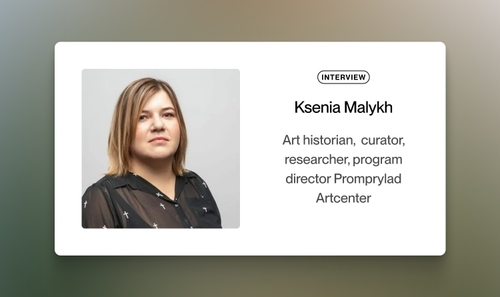The Invisible Architecture: Ksenia Malykh on Building Institutions for the Future

Anna Avetova

Table of Contents
From a DIY gallery to a research platform to a new cultural center in post-industrial Ivano-Frankivsk, Ksenia Malykh has learned that true institutions are built not of facades, but through method, memory, and community.
When people talk about “institutions of the future,” they often imagine new buildings, fresh budgets, and prestigious names. For Ksenia Malykh, the work begins elsewhere—with a method, with the way knowledge is organized: in memory and in the community that gathers around a living program. Over two decades, she’s moved from running a DIY gallery in Kyiv to heading research at one of Ukraine’s largest art institutions, and now to developing a public cultural center in Ivano-Frankivsk that combines research, education, and genuine accountability to its audience.
From DIY to Institution
Malykh’s first institution was Closer in Kyiv: a model radical in its simplicity—no departments, no large staff, just a small team hanging artworks, repairing walls, and opening doors. "I realized you don’t need permission to begin," she recalls. That lesson, shaped by constraints and urgency, now echoes at another scale in her work at Promprylad.Renovation—a cultural center growing out of a former industrial facility in Ivano-Frankivsk. The contexts differ, but the principle holds: start where you are, invite others in, build systems that can adapt.
The distance between Closer and Promprylad is not a rejection of the DIY ethos, but a lesson in scaling and responsibility. The new center is not a monument, but a prototype for institutional models suited to today’s realities: agile, transparent, and accountable to its communities.
Research as Infrastructure
At PinchukArtCentre, Ksenia gradually moved from a team member to leading the Research Platform - a long-term initiative documenting contemporary Ukrainian art history through profiles, interviews, digitization, and exhibitions. A key project, "Parkomuna: Place, Community, Phenomenon," explored the history and legacy of a 1990s artist collective, helping to preserve and contextualize a vital period of Ukrainian practice that might otherwise be lost or oversimplified.
Research and archiving are not auxiliary tasks—they are the scaffolding upon which institutions stand.
This insight carries forward: research is not an ancillary function, but infrastructure. Without it, institutions lose direction, artists lose context, and history turns to myth. For Ksenia, this is not theoretical—it is about survival, ensuring that the artistic experiments and contradictions of the 1990s are not forgotten or flattened into a single narrative.
Archiving Memory in Wartime
The importance of institutional memory has only sharpened. Malykh insists the art scene’s resilience depends on properly archiving and making accessible its records, images, and testimonies. Digitization can’t replace physical encounters with art, but preserves knowledge, enhances research, and lets international colleagues grasp the breadth of Ukrainian practice. In times of real risk to collections, studios, and private archives, responsible digital preservation is not a luxury—it's a public duty.
It’s not about indiscriminately uploading everything online, but about strategic, thoughtful stewardship: knowing what must be preserved, in what form, and how to make it discoverable without exploitation or misuse.
Education as DNA
In Ivano-Frankivsk, Ksenia and her team started not with exhibitions, but with education. The School of Cultural Competencies launched three tracks: art management, curating, and art criticism, primarily online for students from across Ukraine, supplemented by practical offline workshops. Their vision: graduates able to work in institutions, initiate their own projects, and help build a sustainable cultural ecosystem.
In parallel, a teen program is being piloted. Ksenia believes trust and curiosity for art among young audiences are built early and intentionally. These educational initiatives are not peripheral—they are central to the institution’s identity.
Audience and Accessibility
We aim for democratic dialogue about art.
This is not about simplifying art itself, but the path to it: clear labels that clarify rather than mystify, public programs that deepen understanding, language that invites participation rather than erects barriers. The institution maintains an open platform for proposals from emerging curators and artists, while keeping a coherent programmatic line. It’s a delicate but essential balance.
We do not simplify art—we simplify the path to it.
Ethics and Pace
In developing Promprylad’s cultural center, compromises have been applied to pace and pedagogy, but not to values. Some ideas require time and sensitive framing; the team's task is to meet audiences where they are—without diluting content. The war has only intensified these choices: every project is now evaluated for relevance, quality, and responsibility. The criterion is not comfort, but clarity.
Ethical practice does not mean perfection, but honesty about limitations, transparency in decision-making, and genuine willingness to be accountable.
Global Perspective, Local Roots
For sustainable international visibility, Malykh stresses the importance of having state cultural policy work in partnership with independent initiatives. The initial surge of global interest in Ukraine has changed; now, quality, partnerships, and consistency matter most. Ukrainian professionals must articulate and convey their own narratives abroad—not waiting for outside validation, and not operating in isolation.
Simultaneously, institutions at home must develop the capacity to produce new works, provide curatorial support, and help artists between projects. International recognition is important, but local infrastructure is fundamental.
Starting from Zero, as a Team
Upon arriving in Ivano-Frankivsk, Ksenia and her colleagues began with invisible architecture: aligning supporters, forming a board, assembling a team, developing spatial concepts with architects, and designing education-first models of engagement. The first exhibition will open only after this groundwork is complete. In parallel, collaborations with local makerspaces and engineering collectives are being prepared to bring new materials and technologies to artists, strengthening a layer often missing in Ukrainian art education.
Don’t wait for a green light or a perfect wall. Start where you are, and invite others in.
Continue the Conversation
Want to learn more? Listen to Ksenia Malykh's full conversation on the UFDA Podcast, which is available on Instagram, YouTube, Apple Podcasts, and Spotify.
